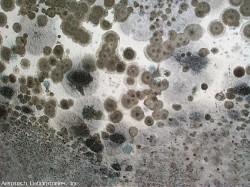If your home has suffered any type of water damage due to leaking pipes, roofing problems or even something as simple as a sink overflow, then you may be at risk for a serious mold problem. Due to the prolific nature of mold especially black mold, it can take as little as 48 hours for that nasty black stuff to begin colonizing inside of the unseen cracks and crevices where water has infiltrated. All this organism needs to begin a colony is moisture which has already been provided during the leakage, warmth which is going to be in anyone’s home especially during the winter and an organic food source which it can devour. Everyday items such as drywall, wood studs and even underneath vinyl flooring are all great food sources for mold and it will feed on some types of organic glues and wooden sub-flooring.
Once black mold has reached a point where it is thriving inconspicuously, you will often begin to smell the mold due to the toxic substances that are produced during the molds growth process. As this organism begins consuming all of the organic raw materials that it comes into contact with, it will begin to create a harmful chemical compound known as mycotoxins. These byproducts are thought to serve as a protection from other microorganisms and are what can be identified by the damp, earthy and musty smell often associated with a mold infestation. Once you can actually smell it, it is definitely time to do a thorough investigation to locate both the source and location of the problem.
The mold itself is not such a terrible thing, it is the toxic spores which it releases into the air which can become allergens and usually have the most dramatic health effects on humans. Once we inhale these spores into our lungs, many symptoms may appear such as coughing, sore throat, dizziness, and even headaches and muscle cramps. Thankfully, it is easy to protect yourself from these problems by preventing mold growth inside of your living spaces.
There are a few simple steps to handling a small black mold problem:
Gather up your safety gear including N-95 face mask, disposable clothing, and rubber gloves.
Seal off the affected area with plastic including any nearby return air vents.
Cut out the drywall and other dampened materials.
Vacuum using a hepa vacuum (available for rental locally)
Spray on a commercially available mold control spray and allow to dry. (concrobium sprays work well)
Dispose of all materials and clothing in contractor grade bags.
Don’t be afraid of tackling the black mold removal problem in your home if you are able to do so, you will save some (maybe a lot) of money and have the satisfaction of knowing you licked it yourself.

















